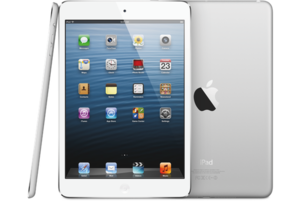
The iPad 2 is two-and-a-half years old. In tech terms it's not just dated, it's carbon dated. And yet the state of the iOS art for spring 2011 is powering the iOS device I use (and love) the most: The iPad mini.
With Apple widely expected to be launching a new iPad mini (and a lot more!) on Tuesday, it's worth revisiting what makes the iPad mini such a compelling product.
It's not a Retina display—the iPad mini is still styling the original iPad pixel count of 1024 x 768, albeit compacted down to a slightly denser 163 pixels per inch due to the mini's smaller screen.
If the iPad mini's appeal is being thin and light, it can't put on too much weight in order to power that Retina display.
It's not the speed of the device. Powered by the A5 processor, the iPad mini is technology that's two generations older than the current-model iPad. Even pushing one quarter of the pixels of the fourth-generation iPad, it lags behind in frame rates. It runs iOS 7—barely.
The appeal of the iPad mini is simple: It's roughly half the weight and volume of the full-sized iPad. At less than seven-tenths of a pound, the iPad mini is easy to hold in one hand for extended periods of time. It's small and light and convenient. As a frequent reviewer of iPads, I always have a full-sized iPad around either at home or at work—but I almost never use it.
I bought my iPad mini mostly so we'd have another unit to use for testing and reference at work. But as I used it, I discovered something that surprised me: I couldn't bear to give it up. It's undoubtedly the iOS device I've logged the most time on in the past 12 months.
 Image: Apple
Image: Apple
When I consider what Apple should do to improve the iPad mini in its second generation, speed is at the top of my agenda. The new iPad mini should be as fast as the fourth-generation iPad, capable of running iOS 7 with aplomb.
I'm a bit more equivocal about the Retina display. I think adding a high-resolution display to the iPad mini would be a great move, don't get me wrong—but going Retina comes with costs. As we saw in Apple's transition to a Retina display on full-sized iPads, those displays use a whole of power. The third-generation iPad was thicker and heavier than its predecessor, in order to pack in more battery capacity. If the iPad mini's appeal is being thin and light, it can't put on too much weight in order to power that Retina display.
If there's anything I've learned from the last year of using the iPad mini, it's that I under-equipped it. I bought the cheapest option, the $ 329 16GB Wi-Fi model. If I had to do it all over again, I'd have ordered at least 32GB of storage. I might have upgraded to the cellular model, too. I bought the thing as a curiosity, but it turned into a workhorse.
If I had to make a prediction, it would be that the new iPad mini will have a Retina screen and internals based on the fourth-generation full-sized iPad, all in a device imperceptibly thicker and heavier than the current model. Maybe that's wishful thinking.
If Apple does break the Retina barrier on the iPad mini, I hope it keeps an upgraded non-Retina model around for a lower price. As I've seen in the last year, the non-Retina iPad mini is still an excellent device. It just needs to be faster than an iPad 2. I'm pretty confident that Apple will make that happen, Retina or no.
Subscribe to the MacWeek Newsletter
Thank you for sharing this page.



No comments:
Post a Comment